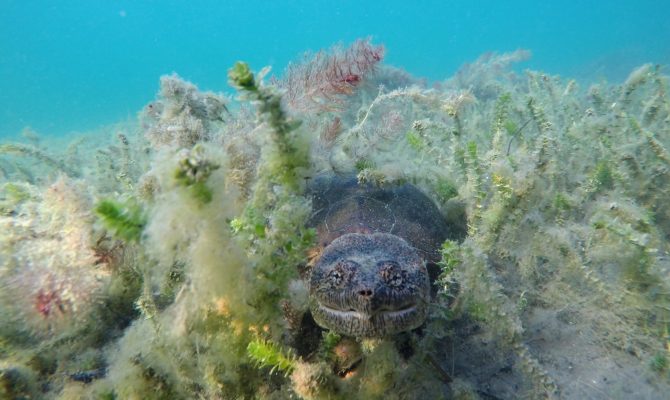The wide angle and incredible depth of focus of the camera provided a novel perspective above and below the surface. This, along with the sturdy case, allow for out-of-the-box thinking even if you aren’t into extreme sports. So, we experimented. We sent it aloft on the top of our boat’s mast, off her stern on an 8-foot-pole, and thrust it down among the weeds to shoot bass under the dock.
Reflections and odd lighting effects made unexpected, even surreal, effects underwater. I had great fun paddling around in the shallows “photo fishing” from our dinghy. My usual technique was to attach the camera to a 6-foot aluminum pole using one of the GoPro’s pricey but handy plastic fittings. Since the Hero4 doesn’t have a viewfinder, you use a smartphone for setup and viewing.
You’ll need clear water and plenty of sunlight. When I “fished” on overcast days, the photos were flat and less than inspiring. The camera also has limits dealing with areas of high-contrast lighting. Turning off the “spot” mode exposure setting helps some.
Colors underwater quickly wash out to become blue or green as you descend. Nearly all my fish photos were from a dinghy or dock at depths of less than 4 feet. To go deeper, you may need to install a red filter. The company makes several, according to the depth at which you plan to shoot.
On the surface, watch out for water drops on the case in front of the lens and fogging when you pull the camera out of cold water. Holding the pole steady also can be a problem. If the boat is rocking, videos will show that up and down motion.
When I was stalking fish in the shallows, I sometimes set the pole end and camera on the bottom near the subject. It isn’t always easy to tell if you’re pointing it at the fish; you may want to adjust your angle to look outward rather than straight down if you’re floating along “trolling” for a big one.
The GoPro website points out that using the highest available resolution gives you a little space for cropping the photo. Find more tips online for underwater photos (mostly for snorkeling and scuba diving). MSRP: $500. www.gopro.com
Author: Susan Gately




